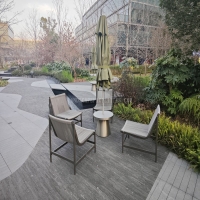Welcome to the website for landscape facilities products and knowledge.
How can a landscape bar counter be designed to minimize glare from sunlight on reflective surfaces?
Designing a landscape bar counter that minimizes glare from sunlight requires thoughtful consideration of materials, positioning, and protective elements. The first strategy involves selecting matte-finish or textured materials for counter surfaces. Unlike glossy materials that reflect light directly, matte surfaces diffuse sunlight, significantly reducing glare while maintaining aesthetic appeal.
Strategic positioning represents another crucial approach. By orienting the bar counter perpendicular to the sun's path during peak usage hours, designers can minimize direct sunlight exposure. This orientation consideration should account for seasonal sun position changes, particularly in outdoor settings where the bar will be used year-round.
Incorporating permanent shading structures offers an effective long-term solution. Pergolas with adjustable louvers, fixed canopies, or architectural elements designed to block high-angle summer sun while allowing lower-angle winter sunlight create functional protection. The spacing of overhead elements should be calculated based on the sun's angle at different times of day and seasons.
Installing specialized anti-glare films on existing reflective surfaces provides a practical retrofit option. These virtually invisible coatings reduce reflectivity while maintaining the visual characteristics of underlying materials. Modern anti-glare treatments can block up to 90% of reflected light without altering the surface appearance.
Landscape integration serves as both functional and aesthetic solution. Strategically placed vegetation, such as deciduous trees or tall shrubs, filters sunlight naturally. This approach creates dappled light effects while providing seasonal adaptation—allowing winter sunlight when leaves have fallen and providing maximum shade during summer months.
For bars near water features or other highly reflective elements, secondary barriers might be necessary. Low walls, decorative screens, or glass barriers positioned to block reflection paths can interrupt glare vectors without compromising the open atmosphere of outdoor entertaining spaces.
Lighting professionals recommend considering ambient light enhancement as a complementary strategy. By incorporating subtle ambient lighting around the bar area, the contrast between bright reflective spots and shadowed areas is reduced, making remaining glare less noticeable to the human eye.
Advanced solutions include computer-assisted sun path analysis during the design phase. Using solar mapping software, designers can predict glare patterns throughout the year and implement precise countermeasures before construction begins. This proactive approach often reveals unexpected glare sources that might be overlooked in conventional planning.
Regular maintenance protocols complete the comprehensive glare reduction strategy. Keeping surfaces free of water spots, dust, and polished finishes that might develop over time ensures that the initial anti-glare measures remain effective throughout the bar counter's lifespan.
Related search:

Recommendation
Metal structure rattan chair without armrests for single person, with woven seat and backrest.